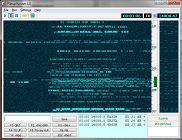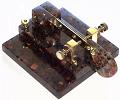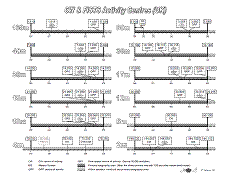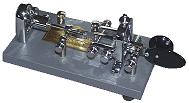FISTS supports the use, preservation and education of Morse code. The club is devoted exclusively to CW operators, CW operating and people who are passionate about Morse code.


We have three straightforward goals:
Further the use of CW (Morse Code)
Engender friendships among members
Encourage newcomers to use CW (Morse Code)
Further the use of CW (Morse Code)
Engender friendships among members
Encourage newcomers to use CW (Morse Code)
FISTS UK is the Headquarters of the FISTS Club (International Morse Preservation Society).

Interested in becoming a member?
Find out more about our history.


Interested in becoming a member?
Find out more about our history.

27 Sep 12: Pileup Runner is a simulator of DX pileups. It is intended for the DX-pedition operators and those who are curious how the pileup looks and sounds at the DX side.
Compared to Morse Runner, which is a contest simulator, Pileup Runner has an extra dimension: frequency. In this program just working the callers is not enough. To be successful, you also have to tune your receiver through the pileup in a smart way.
The program is freeware, currently in the beta stage. Grab a copy at http://www.dxatlas.com/PileupRunner !
73 Alex VE3NEA
Interested in becoming a member?
Compared to Morse Runner, which is a contest simulator, Pileup Runner has an extra dimension: frequency. In this program just working the callers is not enough. To be successful, you also have to tune your receiver through the pileup in a smart way.
The program is freeware, currently in the beta stage. Grab a copy at http://www.dxatlas.com/PileupRunner !
73 Alex VE3NEA
Interested in becoming a member?
Benefits of membership include:
Our popular Quarterly A5 News Booklet
Free use of the FISTS QSL Bureau
Access to our members-only area
Help and support from like minded people
Our popular Quarterly A5 News Booklet
Free use of the FISTS QSL Bureau
Access to our members-only area
Help and support from like minded people
The FISTS Club is one of amateur radio's fastest growing organisations. It's an unique club, founded and maintained on solid principles using radio's oldest and yet most reliable communications mode - CW! Why notjoin us?
FISTS History
The FISTS Club, (International Morse Preservation Society) was founded in 1987 by the late Geo Longden G3ZQS of Darwen, Lancashire England, after recognising a need for a club in which veteran operators would help newcomers and less-experienced operators learn and improve CW proficiency. During the first year, membership reached 300, most of whom were in Great Britain and Europe. The original Introduction to FISTS by Geo holds as true today as it did when he wrote it. Geo also explains how he chose the name FISTS.
The North American Chapter was formed in 1990 to assist 11 members in the USA receive the newsletter and as a banking convenience. Nancy Kott WZ8C of Hadley, Michigan was named US representative, a position she still holds but she now handles the affairs of over 7,000 members in the Americas.
The Down Under Chapter (New Zealand / Australia) was formed in 1998 to provide a similar service to Australasian members, with Ralph Sutton ZL2AOH as the VK/ZL representative. From a VK/ZL membership of four, there are now over 100 members "Down Under", principally in New Zealand. The New Zealand membership is the largest in any country outside England, Wales and North America.
The East Asia Chapter was formed in 2004 by a few Taiwanese and Japanese members to provide East Asian members with various services in their native languages.
Worldwide, FISTS members number over 10,000 members, growing each month.Why not join us?
Acknowledgements: Thank you to Dennis K6DF, Bill NT9K and Billy AB4RH for permission to use photographs from their key collections.
Join or Renew

Joining FISTS is easy; we do not ask for any code proficiency level, just a love of Morse code and a desire to keep it alive.
We organise many on-air activies over the year (rather than the traditional 599 contest type activities). We also attend a number of Rallies each year where many members come and have a chat. Membership brings with it a number of benefits:
Our popular Quarterly A5 News Booklet "Key Note".
Free use of the FISTS QSL Bureau.
Access to our members-only area with details of club projects, members lookup details and free-to-use software for radio amateurs.
Help and support from like-minded people.
FISTS History
The FISTS Club, (International Morse Preservation Society) was founded in 1987 by the late Geo Longden G3ZQS of Darwen, Lancashire England, after recognising a need for a club in which veteran operators would help newcomers and less-experienced operators learn and improve CW proficiency. During the first year, membership reached 300, most of whom were in Great Britain and Europe. The original Introduction to FISTS by Geo holds as true today as it did when he wrote it. Geo also explains how he chose the name FISTS.

The North American Chapter was formed in 1990 to assist 11 members in the USA receive the newsletter and as a banking convenience. Nancy Kott WZ8C of Hadley, Michigan was named US representative, a position she still holds but she now handles the affairs of over 7,000 members in the Americas.
The Down Under Chapter (New Zealand / Australia) was formed in 1998 to provide a similar service to Australasian members, with Ralph Sutton ZL2AOH as the VK/ZL representative. From a VK/ZL membership of four, there are now over 100 members "Down Under", principally in New Zealand. The New Zealand membership is the largest in any country outside England, Wales and North America.
The East Asia Chapter was formed in 2004 by a few Taiwanese and Japanese members to provide East Asian members with various services in their native languages.
Worldwide, FISTS members number over 10,000 members, growing each month.Why not join us?
Acknowledgements: Thank you to Dennis K6DF, Bill NT9K and Billy AB4RH for permission to use photographs from their key collections.
Join or Renew

Joining FISTS is easy; we do not ask for any code proficiency level, just a love of Morse code and a desire to keep it alive.
We organise many on-air activies over the year (rather than the traditional 599 contest type activities). We also attend a number of Rallies each year where many members come and have a chat. Membership brings with it a number of benefits:
Our popular Quarterly A5 News Booklet "Key Note".
Free use of the FISTS QSL Bureau.
Access to our members-only area with details of club projects, members lookup details and free-to-use software for radio amateurs.
Help and support from like-minded people.
Ready to become a member or renew?
Used to be a member but let it lapse? Please click here to go to the Re-join page.
Never been a member? Please click here to go to the New Member page.
We look forward to you joining us!
FISTS Frequencies
This page gives details of the FISTS frequencies that you can use to monitor and contact members.
The recommended areas are the following calling frequencies plus or minus 10 kHz. If you are not using QRP (5 Watts output or less), please use the 10 kHz that avoids the QRP areas per the table.
BandFrequencyTo avoid
QRP, extend
160m 1.818 MHz
80m 3.558 MHz Down
40m 7.028 MHz Down
30m 10.118 MHz Up
20m 14.058 MHz Down
17m 18.085 MHz Down
15m 21.058 MHz Down
12m 24.918 MHz
10m 28.058 MHz Down
6m Any CW frequency
4m Any CW frequency
2m 144.058 MHz
If you're a member or not, call on these frequencies at whatever speed you're happy at, be it 5 wpm or 35 wpm, and you will most likely get a reply from one of our members. We pride ourselves on having a friendly, helpful membership that is always ready to assist the newcomer as well as veteran operators.
Notes
When calling CQ, please alternate "CQ FISTS DE ..." with plain "CQ DE ..." calls; FISTS encourages contacts between members and non-members.
When replying to a CQ, please send no faster than the caller. Don't assume if it's a G3/G2 station coming back to your call they will be comfortable at 25 wpm.
If you are asked to QRS ("send more slowly"), please do so.
It's helpful to call CQ at different speeds. Experience has shown that we have many members that are key-shy due to only high speeds being used, so you may get more replies to your CQ call if you drop your speed to below 12 wpm. Give it a try!
If taking part in a FISTS Challenge such as the Ladder, please vacate or pass on the FISTS calling frequency after 5 continuous QSO's.
Due to IARU band plan changes, the 12m frequency is now outside the recommended CW-only area.
Due to the IARU Region 3 band plan, FISTS Down Under (Australia and New Zealand) use 3.528 MHz. They also use 1.808 MHz, but in Europe this frequency is outside the CW band plan area and illegal in some countries, including the UK.
Chart

We have available a handy A4 chart of FISTS frequencies, IARU Region 1 CW band plan areas and QRP frequencies, making it easy to visualise the layout of the CW areas. You can download or print the PDF version or the Microsoft Word version.
Resources
This page provides access to various items including Key Note newsletters and resources you can use to help you learn or improve your Morse code.
Please choose one of the following:
Learning or Improving Morse
Forms and Documents Provides links to various FISTS forms and documents
Activities Results Contains Brasspounder and results documents for FISTS Activities
Key Note Archive (public) Contains Key Notes from 12 months ago to October 1987
Key Note Archive (Members' Area) Contains Key Notes back to October 1987
Measure Callsign Weight Measure the "weight" (time taken to send) of callsigns in Morse
Learning or Improving Morse
Please choose one of the following:
Learning or Improving Morse
Forms and Documents Provides links to various FISTS forms and documents
Activities Results Contains Brasspounder and results documents for FISTS Activities
Key Note Archive (public) Contains Key Notes from 12 months ago to October 1987
Key Note Archive (Members' Area) Contains Key Notes back to October 1987
Measure Callsign Weight Measure the "weight" (time taken to send) of callsigns in Morse
Learning or Improving Morse
There are many options. Computer-based Morse training gives you perfectly-formed Morse code and can provide incentive by giving you scores or other feedback. However, one-on-one Morse training with a human being or live contacts on the radio can be much more fun! A good idea is to mix computer-based training with other activities involving real people. Additionally, human operators rarely send perfect Morse, so getting some practice at listening to morse sent by other people is important.
Some computer-based training allows you to type in what you hear and then provides you with scores and guides your training based on your results. This can give an incentive and sense of achievement. The downside though is that you also need to learn to type quickly and accurately. In fact, the typing in itself can become an obstacle to learning Morse and doesn't reflect real operating practice; most people handwrite brief notes and/or copy in their head only.
Try not to let "stage fright" get the better of you. It's not an exam and there are no marks out of 10! If you miss something your QSO partner sends to you, you can ask for a repeat or just bluff your way out and say there is QRM or QRN - the other person will be none the wiser!
Websites
Some computer-based training allows you to type in what you hear and then provides you with scores and guides your training based on your results. This can give an incentive and sense of achievement. The downside though is that you also need to learn to type quickly and accurately. In fact, the typing in itself can become an obstacle to learning Morse and doesn't reflect real operating practice; most people handwrite brief notes and/or copy in their head only.
Try not to let "stage fright" get the better of you. It's not an exam and there are no marks out of 10! If you miss something your QSO partner sends to you, you can ask for a repeat or just bluff your way out and say there is QRM or QRN - the other person will be none the wiser!
Websites
Learn CW Online (lcwo.net)Fabian Kurz DJ1YFK provides online Morse training via his website http://lcwo.net.
You listen to Morse and then type in what you hear and are scored. A big advantage is that the only software you need is the Adobe Flash Player, which is already installed on most computers. Various features are included such as the Koch Method for new starters, Word and Callsign training for improvers.
W1AW Practice FilesThe ARRL (USA national radio society) provides copies of the W1AW Code Practice MP3 Files for various speeds between 5wpm and 40wpm in MP3 files, which you can either listen to online or download for your MP3 player. These provide a mixture of plain language (taken from the ARRL QST magazine) and callsign training. As well as the most recent files, there are hundreds of additional files available.
Hand Sending Training film (US Army)There's a very entertaining, helpful and humerous US Army training film from 1966 on hand-sending Morse and adjusting keys, entitled "INTERNATIONAL MORSE CODE, HAND SENDING". Part of the film covers American-style hand/arm positioning, but the majority of the film is very relevant to all styles of sending.
South Manchester Radio and Computing Club Practice FilesThe S.M.R.C.C. Morse Practice web page provides MP3 Morse files with text, QSOs and letter groups at 12, 18 and 25 w.p.m.
FISTS CW Course
The FISTS CW Course is a Morse code training package suitable for beginners and improvers. It comprises:
The well known K7QO course on CD to to learn the code (including files containing the texts sent).
Two practice CD's made by our own Mary G0NZA, which are great for people that want to improve from the 12 wpm level.
An A5 booklet with forty-odd pages that includes all the texts for Mary's disks.This package is a real help to anyone that is learning Morse code and we are very happy to be able to offer it.
The price just covers the costs of having the disks mastered and printed and the booklet produced. If you would like a copy, please visit the Club Sales page.
We would like to thank Chuck K7QO and Mary G0NZA for allowing FISTS to produce these disks.
Software
The well known K7QO course on CD to to learn the code (including files containing the texts sent).
Two practice CD's made by our own Mary G0NZA, which are great for people that want to improve from the 12 wpm level.
An A5 booklet with forty-odd pages that includes all the texts for Mary's disks.This package is a real help to anyone that is learning Morse code and we are very happy to be able to offer it.
The price just covers the costs of having the disks mastered and printed and the booklet produced. If you would like a copy, please visit the Club Sales page.
We would like to thank Chuck K7QO and Mary G0NZA for allowing FISTS to produce these disks.
Software
G4FON's Koch Morse TrainerProbably the most popular computer program is Ray Goff G4FON's Koch Morse Trainer. This uses the proven Koch Method and provides additional features for improvers such as Word training. You can also use it to convert text files into Morse code. The program can be used to generate Windows sound (.wav) files. By installing some free MP3 software, you can also use it to generate MP3 files for your MP3 player.
RufzXP Callsign TrainerFor those who have mastered the basics, the RufzXP program by Mathias Kolpe DL4MM and Alessandro Vitiello IV3XYM provides callsign training. As you copy callsigns correctly, the speed gradually increases. You can also see how you compare to other users worldwide by looking at your place in the international RufzXPToplist (submitting your own results to the list is optional). This is quite good fun!
Morse Runner Contest TrainerThe Morse Runner program by Alex Shovkoplyas VE3NEA simulates contest pile ups with interference from other stations etc. Even if you're not interested in taking part in contests, this program can be fun and help you learn to cope when conditions get busy on the air.
Live Practice
Contacts on the AirListen out and / or call CQ at a speed that you prefer on the FISTS Frequencies. You don't need to be a member - FISTS encourages contacts between members and non-members. (However, why not join us?) For Europe, at the time of writing (September 2009), the best frequencies to meet up with FISTS members at distances of between 50 - 200 miles are on 80m around 3.558 MHz.
Pre-arranged ContactsYou can arrange contacts with other people on the air ("skeds"). Please include your location (town/city/country), what frequency bands you can use and your email address or some other means that members can use to contact you. Places you can ask are:
If you're a FISTS member, you can contact volunteers listed on the Arrange Slow Speed Morse (QRS) Contacts web page by email or telephone.
The fistscw Yahoo Group (reflector).
Ask Rob M0BPT activities@fists.co.uk to put a note in the monthly FISTS Brasspounder electronic news letter.
Ask Graham G3ZOD webmaster@fists.co.uk to put an item in the FISTS website news page.
Ask the Key Note editor keynote@fists.co.uk to put a note in the next quarterly FISTS Key Note magazine.
GB2CW Slow Morse TransmissionsThe RSGB (UK National Radio Society) organises slow morse transmissions on 160m, 80m, 6m and 2m from various volunteers around the UK under the callsign GB2CW. See the schedule for days, times and frequencies.
W1AW Slow Morse TransmissionsThe ARRL provides slow Morse transmissions on 160m, 80m, 40m, 20m , 17m, 15m, 10m and 2m from their headquarters station W1AW. Although some distance from Europe, W1AW is frequently audible due to good antennas. See the schedule for days, times and frequencies. Although there are copies of the transmissions available as MP3 files on the ARRL website, it's good practice reading live transmissions over the air along with the inevitable noise and interference.
RSGB Morse Tests and CertificatesThe RSGB (UK National Radio Society) now offers free Morse competency tests and certificates. Many people enjoy the challenge and satisfaction of passing a test that recognises their achievements. These are available for various speeds and are conducted by an examiner. They are not related to licence privileges in the UK or elsewhere.
G4LHI On-air Training Sessions (Huntingdon, UK)Peter G4LHI runs Morse training sessions available in the Huntingdon area at 19:30 on Mondays, 20:00 on Tuesdays & on 2M, 144.7625 MHz, which usually go on until just after 21/22:00. Have a listen & see if you can hear them & just call in on the breaks if you wish. Talk back is on FM on the same frequency. For more information, please contact Peter; his email address is available from his QRZ.COM entry.
South Manchester Radio and Computing Club 2m Practise NetS.M.R.C.C. runs a 2m Morse practise net on Monday evenings.
Books
Pre-arranged ContactsYou can arrange contacts with other people on the air ("skeds"). Please include your location (town/city/country), what frequency bands you can use and your email address or some other means that members can use to contact you. Places you can ask are:
If you're a FISTS member, you can contact volunteers listed on the Arrange Slow Speed Morse (QRS) Contacts web page by email or telephone.
The fistscw Yahoo Group (reflector).
Ask Rob M0BPT activities@fists.co.uk to put a note in the monthly FISTS Brasspounder electronic news letter.
Ask Graham G3ZOD webmaster@fists.co.uk to put an item in the FISTS website news page.
Ask the Key Note editor keynote@fists.co.uk to put a note in the next quarterly FISTS Key Note magazine.
GB2CW Slow Morse TransmissionsThe RSGB (UK National Radio Society) organises slow morse transmissions on 160m, 80m, 6m and 2m from various volunteers around the UK under the callsign GB2CW. See the schedule for days, times and frequencies.
W1AW Slow Morse TransmissionsThe ARRL provides slow Morse transmissions on 160m, 80m, 40m, 20m , 17m, 15m, 10m and 2m from their headquarters station W1AW. Although some distance from Europe, W1AW is frequently audible due to good antennas. See the schedule for days, times and frequencies. Although there are copies of the transmissions available as MP3 files on the ARRL website, it's good practice reading live transmissions over the air along with the inevitable noise and interference.
RSGB Morse Tests and CertificatesThe RSGB (UK National Radio Society) now offers free Morse competency tests and certificates. Many people enjoy the challenge and satisfaction of passing a test that recognises their achievements. These are available for various speeds and are conducted by an examiner. They are not related to licence privileges in the UK or elsewhere.
G4LHI On-air Training Sessions (Huntingdon, UK)Peter G4LHI runs Morse training sessions available in the Huntingdon area at 19:30 on Mondays, 20:00 on Tuesdays & on 2M, 144.7625 MHz, which usually go on until just after 21/22:00. Have a listen & see if you can hear them & just call in on the breaks if you wish. Talk back is on FM on the same frequency. For more information, please contact Peter; his email address is available from his QRZ.COM entry.
South Manchester Radio and Computing Club 2m Practise NetS.M.R.C.C. runs a 2m Morse practise net on Monday evenings.
Books
There is a free, downloadable book entitled The Art & Skill of Radio Telegraphy. This contains much information on learning Morse to a very high standard and is essential reading for anyone with an interest in Morse code.
Another free, downloadable book is Zen and the Art of Radiotelegraphy. This is a Morse tutor book with an emphasis on the psychology.
http://www.fists.co.uk/
Another free, downloadable book is Zen and the Art of Radiotelegraphy. This is a Morse tutor book with an emphasis on the psychology.
http://www.fists.co.uk/



No comments:
Post a Comment